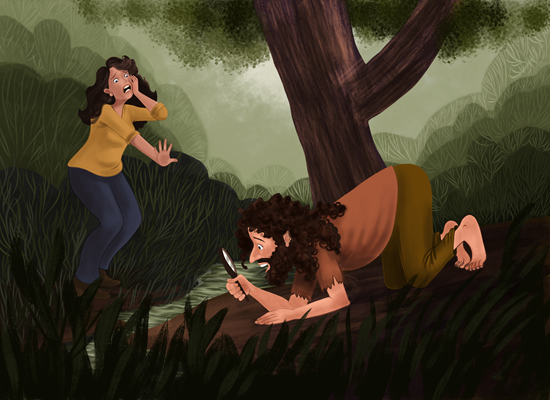Chandra Shekhar (1984)
“It’s sad,” I said. “But Uncle Kevin was 98. He had to go someday.”
Jim scowled. “Easy for you to say. He was my only relative.”
Jim was the only son of an only son who had married an only daughter. His grandparents had no siblings, nor did their parents.
I, on the other hand, had enough aunts, uncles, and cousins to populate a small country. Jim never forgave me for that.
And now his last known relative was dead.
“You don’t know what it is to be all alone,” he said.
“You have me,” I pointed out.

Illustration: Vallabhi Shegaonkar
“You’re not a blood relation.”
I sighed. “Maybe you just need to cast a wider net. You know — find more distant family connections.”
Jim rolled his eyes. But over the next several days, he seemed preoccupied and quiet. So much so that I tried to provoke him.
“Aren’t you overdoing the grief for Uncle Kevin? After all, you barely knew him.”
But Jim didn’t take the bait. “You know, I had an idea. I’ll give my family tree a shake. Maybe it’ll scare up a relative or two.”
It was my idea, but I let it go. Anything for a quiet life — or so I thought.
Charting his family tree kept Jim busy for weeks. He set off to meet a fourth cousin in Melbourne, then a third cousin once removed in Tokyo. He came back from his trips beaming.
“We really hit it off!” he said.
But that didn’t quench Jim’s thirst for new blood connections. He kept climbing his family tree, exploring ever more distant branches.
A fifth cousin from Bihar wrote to him in Hindi; Jim replied via Google Translate. Another invited him to a bullet-ant pain ritual in Venezuela; Jim returned with swollen hands and a big smile. A third cousin twice removed turned out to be Inuit; under his tuition, my vegan, PETA-card-carrying husband killed his first whale.
“And you give me grief for squashing a cockroach!” I said.
Jim’s quest became an obsession. As his exponentially branching family tree encircled the globe, I grew uneasy. It was just a matter of time before…
“Guess what?” Jim said one day. “If we go back twenty generations, you’re related to me by blood!”
If you go back far enough, we’re all related — Genetics 101. Still, realizing it made me queasy.
“Now that my relatives have become yours too, can’t you let it go?” I pleaded.
But Jim was just getting started.
He traced his lineage back through the Middle Ages, though he was stymied by the lack of marriage and birth records.
My relief was short-lived. Jim discovered that DNA genetics could help him trace his ancestry back to the dawn of civilization itself.
“I didn’t realize how inbred the human race is,” he commented.
The day came when Jim traced his line all the way back to Lucy, the first human, who lived 3.2 million years ago.
“Finally, your tree’s complete!” I told him. “You can stop now.”
And I thought he had — until he got arrested trying to sneak into the chimpanzee cage at the zoo.
“I was just visiting my relatives,” he explained to the judge, showing his family tree, which now stretched back seven million years to the common ancestor of humans and apes. The judge ordered him to see a shrink.
That didn’t discourage him. One day I found him shirtless in the backyard, surrounded by a swarm of mosquitoes.
“What do you think you’re doing?” I asked.
“Just having some family over for dinner.”
Jim spent the next few weeks in bed with West Nile.
Undaunted, he kept at it, tracing his ancestry back a billion years to the Proterozoic Eon when plants diverged from animals. After that, Jim couldn’t see a tree without hugging it.
And he refused to mow the lawn.
“How would you like it if I snipped off pieces of your aunts and uncles?” he demanded.
Then he embraced fungi, ciliates, and slime molds, until he had claimed kinship with every multicellular organism on Earth.
“Great,” I rolled my eyes. “What’s next — bacteria?”
It was.
“I didn’t realize I had ten trillion relatives literally living off me,” Jim said. To avoid killing them, he stopped using soap and mouthwash. He also gave up yogurt.
“Do you know how many live lactobacilli there are in a single spoon of it?” he asked.
I really didn’t want to know.
Then Jim embraced viruses — those bits of nucleic acid and protein that straddle the boundary between life and non-life. To show his affection, he refused to get his flu shot.
“Who are you going to hug next?” I asked bitterly. “Prions?”
“No,” he said. “Something more fundamental. The first self-replicating molecule!”
He is now trawling the swamps of Panama in search of this four-billion-year-old mother of all ancestors, believed to still be “alive” and breeding in the primordial slime.
“I can’t wait to meet her!” Jim says.
Me neither. Someone has to talk to him.
END

